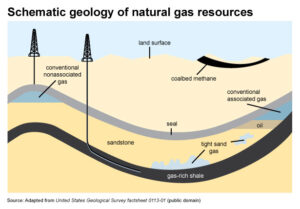Amelia Fauth – September 6, 2023
What the Frack is Natural Gas?
The discovery of fire in the Stone Age altered the course of human evolution. It gave humans the ability to cook food, stay warm, protect themselves from predators, and to venture into colder climates. To this day, combustion of fuels allows for almost everything that humans use. Transportation, electricity, heating, cooling, cooking, food production, and production of everyday items can all be generated due to the combustion of some kind of fuel. Although we have seen innovation into technologies that provide energy by harnessing other forms of our earth’s resources, such as hydropower, solar power, geothermal, wind power, and nuclear energy, the growing demand for energy cannot be fully fulfilled by these means.
Across the globe there is a discrepancy between which fuel sources are used, notably between developed vs. developing nations. With technological advancement, developing nations can convert from burning wood and dung, to more efficient fuel sources like coal, oil, natural gas, and propane. Fossil fuels are all made up of carbon-hydrogen-bonded elements aptly known as hydrocarbons. Society’s modern-day lifestyle relies heavily on energy and electricity, and hence a transition to less carbon-intensive fuels.
The word natural gas may have been heard as a part of current energy conversations and is especially apparent if you are in and around Alberta’s energy industry, or when talking about heating homes and generating electricity in Canadian winters. So, what does natural gas really mean and why is it so important? Natural gas is extracted directly from gas or oil fields. Natural gas is generally the mix of four common hydrocarbon gases: methane, ethane, butane, and propane. All of these are made up of carbon atoms with single bonds to hydrogen atoms, and the name of the compound depends on how many bonds there are.
Methane has a single carbon atom and four hydrogen atoms and is usually in the highest concentration in the natural gas composition (more than 80%). Ethane has two carbon atoms and six hydrogen atoms and is commonly used as a petrochemical feedstock for ethylene production which can be used to produce polyethylene, the world’s most widely used plastic. Propane has three carbon atoms and eight hydrogen atoms and is commonly used as fuel for barbeques as well as a fuel source in rural areas. Butane has four carbon atoms and ten hydrogen atoms and is often known as the fuel in lighters and blowtorches.
To clarify further, crude oil is the mixture of hydrocarbons formed by the remains of ancient organisms that have been subject to heat and pressure from rock layers over millions of years. Petroleum is the name for both crude oil as well as petroleum products refined from crude oil. Gasoline, also known as octane or petrol, is produced by separating and processing different portions of crude oil/petroleum through a refining process. Gasoline is typically in a liquid phase and is a mix of various hydrocarbons with a blend of various additives to meet engine combustion performance levels.
This may sound very similar to natural gas, and to some extent, they are similar, as they are both hydrocarbon mixes being extracted from reservoirs. The main difference between them is their molecular makeup. The complexity of the hydrocarbon mixes in crude oil makes it more difficult to refine and requires further refining for commercial use. Methane, the main component in natural gas, has a simple chemical make up and is therefore easier to use without much refining.
Let’s explore the fracking part of our energy recovery processes. Hydraulic fracturing, also known as fracking, has transformed the Canadian energy market. To add some context, until the 1990s conventional oil and gas located in naturally occurring accumulations/pools in rock openings were drilled using vertical wells that went straight down into the pocket. However, oil and gas found in porous regions and tight rocks required technological advancement to access the resource economically. The advancement that was created was horizontal drilling and hydraulic fracturing, where a fluid mix is pumped down the well under high pressure and fractures the rock so that the oil can flow into the well for extraction. The well that is drilled is typically found two to three kilometers below the surface, and below drinkable groundwater.
 Via U.S. Energy Information Administration
Via U.S. Energy Information Administration
You may remember from your high school science class that gases can be condensed into a liquid phase if they experience a cold enough temperature. This is the case for liquified natural gas (LNG), where the natural gas in gaseous form is put under cold temperature of approximately -160° C. The liquefaction removes water, oxygen, carbon dioxide and sulfur compounds that may be found in the natural gas. This means that the product will be relatively pure methane with small amounts of other hydrocarbons and nitrogen. In liquid form, natural gas can be easily transported as it takes up approximately 1/600th of the original volume.
With so many fuel sources, which one is the best? Reducing CO2 emissions is at the top of most countries’ considerations when looking at climate change reduction plans. The best choice for a fuel source depends on the heat content that is released when the fuel undergoes combustion as well as the emissions released in the process. A BTU (British Thermal Unit) indicates the energy efficiency of a compound, it is the amount of heat needed to raise the temperature of one pound of water. When comparing CO2 emissions per million BTU, Coal has a much higher value than that of propane, natural gas, and motor gasoline.
Coal not only has high CO2 emissions when it is burned, it also emits other toxins such as mercury, sulfur dioxide and nitrogen oxides. As the world looks to transition to fuels with less emissions natural gas and propane can be considered clean burning fuels. IHS Markit estimates that switching just 20% of Asia’s many coal-fired power plants to natural gas would prevent an estimated 680 megatonnes (MT) of CO2 emissions annually. To put this in context, Canada’s annual emissions are 672 MT. In other words, switching just 20% of Asia’s coal-fired power plants would save the equivalent of “one Canada” in terms of annual emissions, while switching 40% would save “two Canadas”.

Now I hope you might be able to explain what the frack natural gas is.
